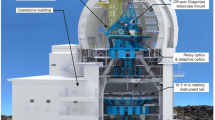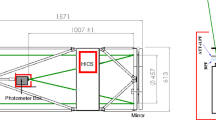Abstract
The development of telescope capabilities tends to go in spurts. These are triggered by the availability of new techniques in optics, mechanics and/or instrumentation. So has nighttime telescope technology developed since the construction in the nineteen-forties of the 5-m Hale telescope, first by the introduction in the sixties of high efficiency electronic detectors, followed recently by the production of large 8- to 10-m mirrors and now by the implementation of adaptive optics. In solar astronomy, major steps were the introduction of the coronagraph by Lyot in the nineteen-thirties and the vacuum telescope concept by Dunn in the sixties. In the last thirty years, telescope developments in solar astronomy have relied primarily on improved instrumental capabilities. As in nighttime astronomy, these instruments and their detectors are reaching their limits set by the quantum nature of light and the telescope diffraction. Larger telescopes are needed to increase sensitivity and angular resolution of the observations. In this paper, I will review recent efforts to increase substantially the telescope capabilities themselves. I will emphasize the concept of a large all-wavelength, coronagraphic telescope (CLEAR) which is presently being developed.
Similar content being viewed by others
References
Beckers, J. M.: 1962, Bull. Astr. Inst. Neth. XVI, 133.
Beckers, J. M.: 1988, in R. J. Rutten and G. Severino (eds.), Solar and Stellar Granulation, Kluwer Academic Publishers, Dordrecht, Holland, p. 55.
Beckers, J. M.: 1994, in J. R. Kuhn and M. J. Penn (eds.), Infrared Tools for Solar Astrophysics: What's Next?, World Scientific Publishers, Singapore, p. 145.
Beckers, J. M.: 1996, in F. Roddier et al. (eds.), Adaptive Optics for Astronomy, Cambridge University Press, Cambridge, in preparation.
Beckers, J. M.: 1997, Experimental Astronomy, in preparation.
Dunn, R. B.: 1969, Sky Telesc. 38, 368.
Fried, D. L.: 1966, JOSA 56, 1372.
Hammerschlag, R.: 1981, in in R. B. Dunn (ed.), Solar Instrumentation: What's Next?, p. 547.
Harvey, J. W., Hill, F., Hubbard, R. P., Kennedy, J. R., Leibacher, J. W., Pintar, J. A., Gilman, P. A., Noyes, R. W., Title, A. M., Toomre, J., Ulrich, R. K., Bhatnagar, A., Kennewell, J. A., Marquette, W., Patron, J., Saa, O., and Yasukawa, E.: 1996, Science 272, 1284.
Hecquet, J. and Coupinot, G: 1985, J. Optics/Paris 16, 21.
Keller, C. U.: 1996, CLEAR R&D Note 96-5.
Lofdahl, M. G. and Scharmer, G.: 1994, Astron. Astrophys. Suppl. 107, 243.
Rayrole, J.: 1990, Astronomie 104, 390.
Rayrole, J., Mein, P., and Cavallini, F.: 1994, in R. J. Rutten and S. J. Schrijver (eds.), Solar Surface Magnetism, Kluwer Academic Publishers, Dordrecht, Holland, p. 507.
Scharmer, G., Brown, D. S., Petterson, L., and Rehn, J.: 1985, Appl. Optics 24, 2558.
Smartt, R. N.: 1996, Austr. Optical Soc. News 10, 27.
Smartt, R. N., Koutchmy, S. L., Colley, S. A., Caron, R., Schwenn, R., and Restaino, R. R.: 1990, Proceedings SPIE 1236, 206.
Author information
Authors and Affiliations
Additional information
Dedicated to Cornelis de Jager
Rights and permissions
About this article
Cite this article
Beckers, J.M. Comments on the next generation of ground-based solar telescopes. Sol Phys 169, 431–442 (1996). https://doi.org/10.1007/BF00190619
Received:
Issue Date:
DOI: https://doi.org/10.1007/BF00190619




